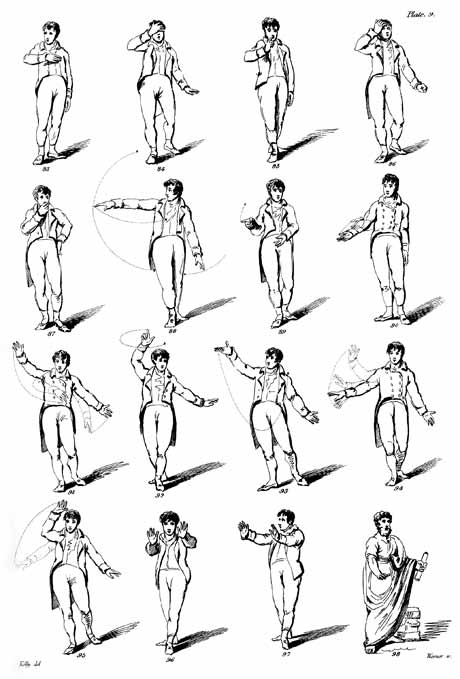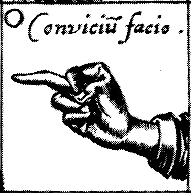Canons of Rhetoric: Delivery
Peaky Blinders, Season 5, Episode 6, 1:30.
 Delivery is about voice -- intonation, pitch, and volume -- as well as gesture and posture and movement, even how one should dress. Rhetorics which focus on literate practices have tended to ignore delivery because texts are disembodied. Oral cultures, one the other hand, have tended to emphasize delivery. The famous Attic orator Demosthenes is said to have answered the question "What are the three most important factors of speech making?" by saying, "Delivery, delivery, delivery." (see On the Ideal Orator, 3.213. See also Quintilian, Institutes of Oratory 11.3.6-7.)
Delivery is about voice -- intonation, pitch, and volume -- as well as gesture and posture and movement, even how one should dress. Rhetorics which focus on literate practices have tended to ignore delivery because texts are disembodied. Oral cultures, one the other hand, have tended to emphasize delivery. The famous Attic orator Demosthenes is said to have answered the question "What are the three most important factors of speech making?" by saying, "Delivery, delivery, delivery." (see On the Ideal Orator, 3.213. See also Quintilian, Institutes of Oratory 11.3.6-7.)
Aristotle also thought delivery was important, but he was ambivalent about it as a subject matter and as a rhetorical force. "Delivery seems a vulgar matter when rightly understood. But since the whole business of rhetoric is with opinion, one should pay attention to delivery, not because it is right but because it is necessary, since true justice seeks nothing more in a speech than neither to offend nor to entertain; for to contend by means of the facts themselves is just, with the result that everything except demonstration is incidental; but nevertheless, [delivery] has great power ...because of the corruption of the audience. ... Acting is a matter of natural talent and largely not reducible to artistic rule.[1404a]"
There is no such ambivalence toward delivery in the author of Rhetorica ad Herennium
Many have said that the faculty of greatest use to the speaker and the most valuable for persuasion is Delivery. For my part, I should not readily say that any of the five faculties is the most important; that an exceptionally great usefulness resides in the delivery I should boldly affirm. For skillful invention, elegant style, the artistic arrangement of the parts comprising the case, and the careful memory of all these will be of no more value without delivery, than delivery alone and independent of these. (3.11.19)
In On Invention Cicero offers the following definition, " Delivery, is a regulating of the voice and body in a manner suitable to the dignity of the subjects spoken of and of the language employed." (Book 1, section 7)
Quintilian considered delivery important enough to devote an entire chapter to it in book 11 of his 12 volume set on Rhetoric, where he asserts, (E-text)
There is no proof -- that proceeds in any way from a pleader -- of such strength that it may not lose its effect unless it is supported by a tone of affirmation in the speaker. All attempts at exciting the feelings must prove ineffectual unless they are enlivened by the voice of the speaker, by his look, and by the action of almost his whole body.
His advice is far more specific and detailed than anything prior. Here is a small piece for example.
To secure grace it is essential that the head should be carried naturally and erect. For a droop suggests humility, while if it be thrown back it seems to express arrogance, if inclined to one side it gives an impression of languor, while if it is held too stiffly and rigidly it appears to indicate a rude and savage temper. (Institutes vol. 4, p 283)
For Quintilian delivery comes down to propriety, what is best suited to the occasion and the circumstances. As always he warns against the excess. "In our attempt to ape the elegances of the stage, we shall lose the authority which should characterize the man of dignity and virtue." (p 349)
Quintilian's chapter on delivery is worth reading in its entirety.
Interestingly, the 16th century French humanist Peter Ramus (1515 -- August 26, 1572), who is often presented as a villain in the history of rhetoric for having excluded invention from the canons and having focused almost entirely on stylistic expression, nevertheless did see delivery, or "action" as important:
His second main topic action which deals with suitable delivery had been valued up to this time but had not been explicitly taught. With Ramus this subject comprises the use of the voice and gestures. Under the head of vocal control he discusses how both in the case of single words and of sentences or combinations of words expression may be given through proper modulation to the various emotions such as fear, grief, and sympathy. Under the other division he deals with all the details of effective expression through gestures with the body, head, eyes, arms, hands, and fingers, and with the kind of gesticulation to be avoided. Peter Ramus and the educational reformation of the sixteenth century. Frank Pierrepont Graves.
Several hundred years later, in eighteenth-century northern Europe and America, handbooks on delivery appeared with illustrations of all the supposedly appropriate ways to stand in order to evoke and express emotions: hands out, palms up for supplication, a raised fist for anger, and so on. This period is sometimes referred to as the elocutionary movement.
Here is a definition of elocution from one of the textbooks of the time,
Elocution is the art of delivering with ease and propriety; written or extemporaneous composition.
Good reading or speaking, therefore, may be considered not only as uttering the words of a sentence so that it may be distinctly heard, but also giving them all that force and variety of which they are susceptible.
The prime qualification of an orator, is a pure and cultivated voice; therefore, knowledge of the right use of the breathing apparatus, together with the proper manner of disciplining and using the voice, is the first subject the student should notice. Charles A. Wiley. Elocution and Oratory: Giving a thorough treatise on the art of Reading and Speaking. New York: Clark and Maynard, 1869. p 15. (Google book link)
 It's interesting the lengths to which scholars in the 18th century went to catalog hand gestures and postures. Left is a plate from Gilbert Austen's Chirnomia .
It's interesting the lengths to which scholars in the 18th century went to catalog hand gestures and postures. Left is a plate from Gilbert Austen's Chirnomia .
For more examples of such advice, see
- Gilbert Austin. Chironomia: A Treatise on Rhetorical Delivery (Google books link)
- John Bulwer. Chirologia or The Natural Language of the Hand (Google books link)
- Henry Siddon. Practical Illustrations of Rhetorical Gesture and Action (Google books link)
- Thomas Sheridan. A Course of Lectures on Elocution (Google books link)
- Ray Nadeau. Delivery In Ancient Times_Homer to Quintilian (pdf)
Today it seems more than a little arcane to be concerned for pronunciation. In fact, were one to correct a student's pronunciation one might be denounced for an elitist or worse. Still, an impenetrable accent can be a rhetorical handicap. Demosthenes, by the way, is said to have perfected his pronunciation and the strength of his lungs while practicing declaiming with a mouth full of pebbles in a cave by the sea, where he had to strain to be heard over the crashing waves. Apocryphal no doubt, but an interesting indication of the traditions' value for enunciation and projection.
While much of this kind of rhetorical advice seems dated, I am reminded of it by the signing, posturing, and dancing on short form video platforms like TikTok. In these settings you are included and excluded to the extent you know the moves and can perform them well. In nearly any culture, people will infer a great deal a bout a person's competence and intention from the way a person walks and stands and sits. Consider the number of books available today on "body language".

Hakini Mudra
"The Ancient Origin of Hand Gestures in Iconography", is a short and tantalizing glimpse of how ancient Greek rhetorical tradition influenced subsequent Christian art and non-verbal communication.
Consider also the Hindu tradition of Hasta Mudra, hand postures. The idea here is that holding your hands in specific ways leads to specific changes in internal states. They are internally directed forms of motion rather than externally directed forms of communication, although it's not impossible that all physical movements move both ways. There is at least 1 Mudra, Hakini, the posture of power and concentration, which seems to have a direct parallel in contemporary Western public speaking manuals. The "tent" gesture resembles Hakini and is also said to both signify and create power and concentration.
For a relatively recent discussion of delivery, have a look at Gesture: Visible Action as Utterance. Adam Kendon. Cambridge: Cambridge UP, 2004. (Google link).
You might also find Regendering Delivery: The Fifth Canon and Antebellum Women Rhetors, from the Studies in Rhetorics and Feminisms, and Southern Illinois University Press series, interesting.
The relationship between gender and comportment, how we are taught to embody and thereby deliver our genders, is a fascinating study in itself, and clearly an offshoot of the canon of delivery.1 Maud Gleason's Making Men: Sophists and Self-Presentation in Ancient Rome is a great book on classical paideia and gender. From Amazon's site: "The careers of two popular second-century rhetorical virtuosos offer Maud Gleason fascinating insights into the ways ancient Romans constructed masculinity during a time marked by anxiety over manly deportment. Declamation was an exhilarating art form for the Greeks and bilingual Romans of the Second Sophistic movement, and its best practitioners would travel the empire performing in front of enraptured audiences." (link) (bio)
Maud Gleason's Making Men: Sophists and Self-Presentation in Ancient Rome is a great book on classical paideia and gender. From Amazon's site: "The careers of two popular second-century rhetorical virtuosos offer Maud Gleason fascinating insights into the ways ancient Romans constructed masculinity during a time marked by anxiety over manly deportment. Declamation was an exhilarating art form for the Greeks and bilingual Romans of the Second Sophistic movement, and its best practitioners would travel the empire performing in front of enraptured audiences." (link) (bio)
Now that most of us have phones capable of recording in high definition and many of us are using video conferencing software, delivery is once again a relevant skill. What online delivery is, how best to light your face, how best to convey what emotions, and so on is, as far as I know, not yet something that has been codified. I'm no doubt wrong about that.
I do know, however, that you can spend a small fortune on lighting for your videos, Google ring lighting. The denizens of TikTok are as we speak perfecting the art of a specific kind of video delivery.
The most recent piece on delivery that I have come across is A New Practical Guide to Rhetorical Gesture and Action. The connection between acting and rhetoric, specifically oratory to the public performance of rhetorical thinking, is as old as Aristotle at least. Cicero says he practically apprenticed himself to the great actor of his day.
I quoted Peaky Blinders above as a way of reminding myself of something. To be convincing you need to sound authentic, and that would suggest empathy on the part of the orator, that they must feel what they want their audience to feel, but that is exactly wrong. If you feel deeply as you speak, your body will betray you. Your heart-rate will accelerate, and you will lose control of your diaphragm. Really great speakers, I think this because I know I am not one for this reason (among others), can bracket their feelings or even perhaps don't feel them to begin with. Great orators, perhaps, are adept at what psychologists call cold empathy, knowing what others feel without feeling it themselves. If you think that's a trait of a psychopath, it is. But of course it is just one trait. For orators, at least for the kind who have to perform live, cold empathy may be the most important trait, and it may be that acting teaches one how to convey emotion without succumbing to it.
Bolter, Jay David and Grusin, Richard. Remediation: Understanding New Media Cambridge: MIT Press, 2000.
James E. Porter, "Recovering Delivery for Digitial Rhetoric" Computers and Composition 26 (2009) 207 - 224.
Reynolds, John Frederick, ed. Rhetorical Memory and Delivery. Hillsdale: Lawrence Earlbaum, 1993.
Welch, Kathleen E. Electric Rhetoric: Classical Rhetoric, Oralism, and a New Literacy (Digital Communication). Cambridge: MIT Press (July 16, 1999) .
 convicium facio -- I provoke (an argument) "The putting forth of the middle finger the rest drawn into a fist on each side ... is a natural expression of scorn and contempt. This gesture is called catapygon by the Athenians, [that is, a fornicator and whore, because he is prone to obscenity and because he arouses a bad reputation and creates a noisy disturbance....] [That is, if he calls you a fornicator you should cast the same aspersion on him and pay him back, raising your third finger which is the sign of a fornicator; for it is used not only to denote derision but also disgrace and weakness of any sort.] (John Bulwer, Chirologia/Chironomia, 132)"
convicium facio -- I provoke (an argument) "The putting forth of the middle finger the rest drawn into a fist on each side ... is a natural expression of scorn and contempt. This gesture is called catapygon by the Athenians, [that is, a fornicator and whore, because he is prone to obscenity and because he arouses a bad reputation and creates a noisy disturbance....] [That is, if he calls you a fornicator you should cast the same aspersion on him and pay him back, raising your third finger which is the sign of a fornicator; for it is used not only to denote derision but also disgrace and weakness of any sort.] (John Bulwer, Chirologia/Chironomia, 132)"